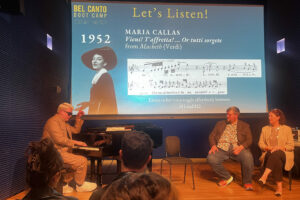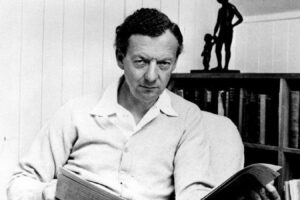

This 1971 performance of Werther is quite a treat, although we’ve grown to have different vocal expectations in the nearly-50 years since then. Franco Corelli, in what was perhaps his last new role, turned 50 just two weeks before this performance and approaches Goethe’s dreamy, gloomy poet with the passions of Turridu. Régine Crespin, although a mere 44, makes a lusciously-sung but somewhat matronly Charlotte, but her artistry and command of her native language almost make up for Corelli’s French.
Last Thursday was the 106th anniversary of Mahler’s death. For many years, Wiener Staatsoper commemorated 18 May with a special memorial concert featuring the Wiener Philharmoniker. Since the last was in 2011, I thought the massive Symphonie Nr. 8 – probably the closest Mahler ever got to composing an opera – would be appropriate.
Leonard Bernstein conducts a 1965 performance with the New York Philharmonic and soloists including Beverly Wolff, Jennie Tourel, George Shirley, and Ezio Flagello, and hundreds of other musicians.
Despite his astounding symphonic works and Lieder, Mahler’s brief life was dominated by conducting assignments specializing in opera, the first of which was Il trovatore. He served as music director of several opera houses throughout Central Europe including theaters in Hamburg, Prague, Budapest, and, most notably, a decade of innovation at the helm of the K. & K. Hofoper (the name of Wiener Staatsoper prior to the dissolution of the Hapsburg rule) during which he introduced 33 operas to the repertoire, modernized productions, and conducted 600 performances of the 3,000 given by the company under his tenure.
He was driven from the Hofoper in 1907, the victim of an anti-Semitic attack by press and public, and quickly negotiated the jobs of music director of the New York Philharmonic and the Met. His final performance was at Carnegie Hall in 1911 a few weeks before his death at age 50.
Mahler’s legacy remains intact at Staatsoper, where the main promenade bears his name – the Gustav-Mahler-Saal – which houses a portrait and his collapsible, scaled-down “travel piano” on permanent display, as well as a bust in the adjacent Schwindfoyer.
Despite all of his work conducting operas covering a vast repertoire including world premieres as well as composing numerous works for or featuring voices, he never wrote an opera of his own, although he dabbled in maters such as writing extra music for Le nozze di Figaro and creating a performing edition of Carl Maria von Weber’s unfinished opera Die drei Pintos.
Each summer he would travel to the countryside and seclude himself in a “composing hut,” the most notable of the three situated in the southern Austrian state of Kärnten near Slovenia, in the woods of Maiernigg by the shores of the Wörthersee.
In 1906, he arrived there with the idea of revising his seventh symphony but was struck with a bolt of inspiration and, in a matter of eight weeks, he instead wrote the entire eighth. Given its call for huge choral forces and eight soloists, plus the inclusion of religious text in Latin plus a setting of the final scene of Goethe’s Faust, it comes as close to his own opera as he ever got. He disdained the name “Symphony of a Thousand” conceived by a concert promoter to sell tickets to the 1910 world premiere in Munich, the last premiere of one of his compositions he would hear in his lifetime.
After an initial burst of performances in Europe and in America (where Leopold Stokowski led the American premiere with the Philadelphia Orchestra at the Academy of Music in 1916), interest in the symphony dwindled due to its call for so many performers and the dire conditions of two world wars.
The work saw post-war revivals, championed by conductors such as Adrian Boult, Stokowski, Hermann Scherchen, Jascha Horenstein, and Dimitri Mitropoulos.
Bernstein was likely the man most responsible for the popularization of Mahler in the 1960s with his performances with his New York Philharmonic and the first complete recordings of the symphonies.
This is how I began my lifelong love of Mahler, who remains one of my four composer deities. My dads invested in the Columbia Masterworks set, with the LPs stored in pages of sleeves in a binder which was housed in a shiny black box adorned with a gold medallion of Mahler.
As Stephen Sondheim noted in Company, Mahler was a fad in New York in the 1960s and 1970s, and I attended every performance for which I could score a ticket, with conductors including Bernard Haitink, Pierre Boulez, and Daniel Barenboim. My passion grew even more after moving to Austria, where Mahler is everywhere, and the first time I heard the eighth in live performance.
I was treated to a surprise visit to the Maiernigg “composing hut” in the summer of 2004. After trekking a good while on a narrow path through lush forest, the tiny yellow structure came into view. I and my companion were the only people there aside from the volunteer who was the caretaker of the day. I imagine my feelings were akin to those of devout Catholics entering the Sistine Chapel. I was so in awe I was speechless. The volunteer asked if I wanted to hear some of Mahler’s music on the newly installed sound system and I immediately barked, “No!” I wanted to hear only the sounds of nature Mahler heard.


























Comments